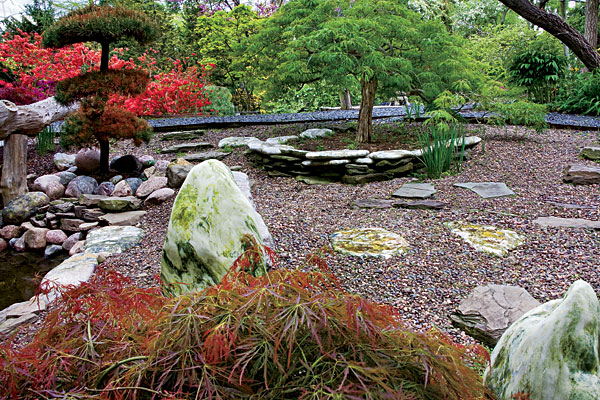
Wormser’s garden combines rocks of many sizes and shapes with varied foliage: the dark needles of a topiary pine (at left), the soft leaves of a Japanese maple (front) and a cedar (rear), and the spiky uprights of irises (center). Photo Gallery »
Some art and antiques provide their own context; they can be displayed just about anywhere, and their owners will have a pretty good idea how to use them—a chair, for instance, or a painting. Not so with an ancient, twisted, perforated, water-gnarled, ten-foot-tall pillar of limestone.
“People love these stones,” but sometimes have trouble imagining how to use them in the garden, says Michael Keeley, Pagoda Red’s creative director, of the Chinese scholars’ stones at the Winnetka and Bucktown stores, which specialize in Asian antiques. To help make the imagining easier, he has created a Chinese-style garden behind the Winnetka store that displays scholars’ stones and other wonders in a suitably serene environment.
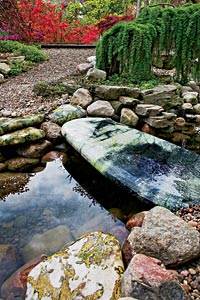
In Ed Wormser’s Northbrook garden, a polished slab echoes the mirror-like surface of the stream and the interaction of trees and sky. Photo Gallery »
The naturally eroded stones, or gongshi, come mostly from watery areas around China’s Lake Tai, on the Yangtze Delta plain, with the most precious of them originating on the lake’s bottom. Used as objects of contemplation as far back as the Han dynasty (206 B.C.-220 A.D), the captivating forms come in many shapes and sizes—evoking mountains, monks, and many other things.
Northbrook resident Ed Wormser has been a fan of Asian gardens since living in Japan several years ago. The garden at his home is a Midwestern adaptation of the Japanese aesthetic, incorporating plants, water, and rocks to suggest larger natural tableaux. “It’s an aesthetic that you respond to immediately or you don’t,” he says. “I do.”
When he first encountered the scholars’ stones in Pagoda Red’s courtyard garden, he appreciated their serenity and poise. “The water has been going through them for centuries and centuries, making these beautiful, unique forms,” he says.
Wormser initially bought two large gongshi and placed them in a prominent spot in his garden; within a few weeks it became clear that they needed a more naturalistic setting. Because the stones are both large and expensive, Keeley says, “people often think they should be put in a very important place in the garden, but after a while they see how much more effective they are in a more contemplative location.” A grouping of stones—the newest and largest weighs five tons—now stands near a waterfall at the edge of Wormser’s large, rocky pond, where it meets a wooded area. It is his own evocation of an earthly paradise.
Photography: Linda Oyama Bryan
Related:
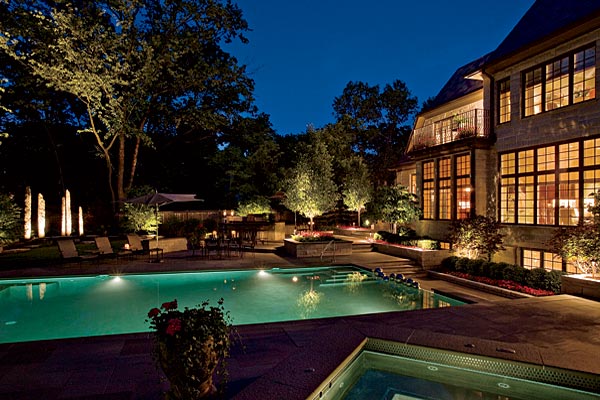
A grouping of gongshi in the Danilek garden has an eerie, ethereal presence when uplit after dark Photo Gallery »
Suzanne Danilek, who says she wanted “a sense of peace” in her Winnetka garden, also discovered the scholars’ stones at Pagoda Red and went on to find a prime location for them at home. When she and her husband, Tom, bought a quintet of stones, their landscape designer, Heidi Sibert of James Martin Associates, created a sort of plinth for them, a raised bed rimmed with a wall of flat stones, at the edge of the garden. The arrangement is within easy view of an outdoor kitchen, dining area, and swimming pool.
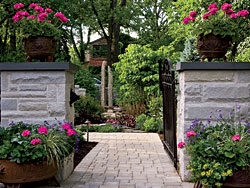
Seen in daylight from outside the gate, the same grouping seems to invite visitors in. The stones are set on a raised bed rimmed with a wall of flat stones for maximum visibility. Photo Gallery »
The scholars’ stones command attention both in daytime and at night, when uplighting illuminates their richly textured surfaces. The grouping makes a dramatic focal point but, given the unadorned nature of the stones, also a simple one. “We didn’t need a lot of little things scattered around the garden,” Danilek says. “One strong move like this did a lot to create the Zen-like feeling that we wanted to have.”
The stones are a pleasure in all seasons. “When they’re covered in snow, I think of the Himalayas,” Danilek says. Other days, they simply direct her thoughts toward serenity. “It’s their ancientness,” she says. “Their age and authenticity—and the texture on them—create a meditative, reflective mood.”
Photography: Linda Oyama Bryan
Related:
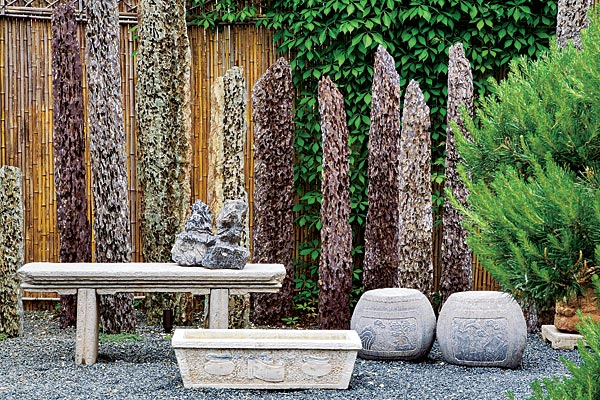
Fu dogs on pillars and oversized pots give the garden a heft and height that youngish, seasonal plants can’t.
Photo Gallery »
To help people visualize ways to use the stones, the Winnetka Pagoda Red’s solution was to un-pave a parking lot and put up a paradise. A few years ago Michael Keeley talked the landlords into letting him transform a little-used narrow space behind the store, meant for parking, into a Chinese-style garden, with design by the innovative landscape designer Craig Bergmann.
The intent was to show antique garden elements, including the scholars’ stones, in a complementary setting, surrounded by tree peonies, bamboo, pines, and other traditional Chinese garden plants (or Midwest-hardy stand-ins). Making such a place had the side benefit of creating a semi-secret oasis where customers and employees could relax in a setting reminiscent of the gardens in ancient China where poets, painters, and calligraphers would “rejuvenate and spend some time with nature,” Keeley says. “A place of solitude.”
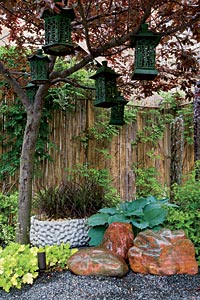
The hosta, Japanese blood grass, and chartreuse-leafed coral bells help suggest vitality and endurance, just as more traditional Chinese selections would. Photo Gallery »
The space, which contains references to all the elements of a traditional Chinese garden, feels far older and more rooted than it actually is. A pair of large courtyard doors and a small tiled-roof overhang suggest the enclosing architecture that an actual Chinese garden would have had. Bergmann chose plants for the way they suggest vitality and endurance (they flower beautifully and last through all four seasons).
Representing the water that in a Chinese garden speaks of the feminine principle of yin, the earth’s blood vessels, there is a koi pond housed aboveground in a substantial ceramic urn. The masculine yang, the skeleton of the earth, is represented by the scholars’ stones, whose tall, rugged profiles resemble steep mountains.
The gongshi—all antiques, not unearthed recently for commercial purposes, Keeley emphasizes—fascinate many customers. While traditionally the stones were thought to evoke mountains, they have also sometimes been seen as towering, benevolent ghosts. Keeley notes that, particularly when they are set in a wooded area, the stones can suggest rough-barked tree trunks. Danilek considers hers a form of minimalist sculpture, and why not? Part of their beauty is that they can suggest so many things—or nothing at all.
RESOURCES: Pagoda Red: 902 Green Bay Rd., Winnetka, 847-784-8881; 1714 N. Damen Ave., 773-235-1188. Craig Bergmann Landscape Design, 1924 Lake Ave., Wilmette, 847-251-8355. James Martin Associates, 59 E. U.S. Hwy. 45, Vernon Hills, 847-634-1660.
Photography: Linda Oyama Bryan
Related:


